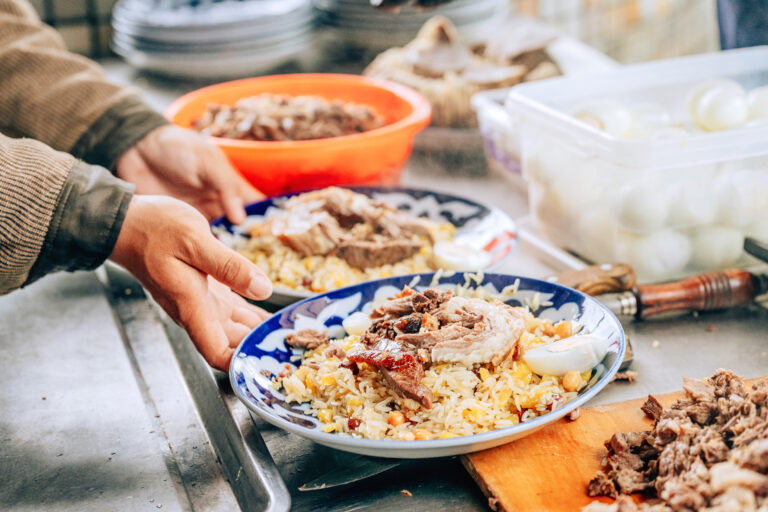Plov, a national dish of Tajikistan, is a culinary delight that has been enjoyed in that country for generations. This hearty meal, often enjoyed at social gatherings and family events, is steeped in tradition and cultural significance.
Our team at Remitly created this guide as part of our series that celebrates the cuisine of people around the world.
The History of Plov in Tajikistan
The origins of plov are shrouded in mystery. Some believe it was born out of necessity during harsh winters when food was scarce. Others argue it was a dish reserved for royalty, served only on special occasions. The truth is that this dish has become a staple food through all of Central Asia.
Regardless of its beginnings, plov has become an integral part of Tajik culture. It’s not just a meal—it’s a symbol of hospitality and community.
Ingredients Used in Traditional Plov
Traditional plov is simple yet flavorful. The main ingredients are rice, meat (usually lamb or beef), onions, and carrots. Spices such as cumin and coriander add depth to the dish.
Some variations include chickpeas or raisins for added texture and sweetness. Regardless of the additions, the essence remains—the perfect balance between savory meat and fragrant rice.
The Cooking Process of Plov
Cooking plov is an art form that requires patience and precision. First, the meat is browned to seal in flavor. Then onions are sautéed until golden before carrots join the mix.
Once these ingredients have melded together, rice is added along with water or broth. The pot is then covered allowing everything to cook slowly until tender—resulting in a one-pot wonder that’s both satisfying and comforting.
A Basic Recipe for Plov
Plov is a dish that invites creativity, but here’s a basic recipe to get you started. Remember, the key to a great plov is patience and attention to detail.
Ingredients:
- 2 cups of long-grain rice
- 1 pound of lamb or beef, cut into chunks
- 3 large onions, finely chopped
- 4 carrots, julienned
- 4 cups of water or broth
- Salt and pepper to taste
- 1 teaspoon of cumin seeds
- Half a teaspoon of coriander seeds
Instructions:
- Rinse the rice under cold water until the water runs clear. Soak it in warm water for about half an hour.
- Heat oil in a large pot over medium heat. Add the meat and brown on all sides.
- Add onions to the pot and sauté until golden.
- Stir in carrots and cook until they soften slightly.
- Drain the rice and add it to the pot along with salt, pepper, cumin, and coriander.
- Pour in enough water or broth to cover everything by about an inch.
- Cover the pot and let everything simmer on low heat for about an hour or until everything is tender.
- Serve hot from the pot with fresh herbs if desired.
Variations of Plov Across Regions
While traditional plov holds its own charm, regional variations add an exciting twist to this classic dish. In some areas, fruits like quince or apricots are added for a sweet contrast against the savory elements.
In others regions garlic bulbs or whole chili peppers are included for an extra kick. Despite these differences each version stays true to the heart of plov— a dish that brings people together.
Serving and Eating Etiquette for Plov
Plov is typically served in large communal dishes, symbolizing unity and shared experiences. It’s customary to eat with your hands, further emphasizing the sense of community.
Before eating, it’s common to say “Bismillah” (In the name of God) as a sign of gratitude. This practice highlights the deep-rooted respect for food and its role in bringing people together.
Role of Plov in Social Gatherings
Plov is more than just a meal—it’s an event. Whether it’s a wedding, birthday or simply a family gathering, plov is often at the center. The process of preparing and sharing plov strengthens bonds and fosters camaraderie. It’s not uncommon for guests to gather around the pot, sharing stories and laughter as they wait for the plov to cook. This shared experience creates lasting memories—making each bite taste even better.
Every family has their own plov story—a cherished memory tied to this beloved dish. For some, it might be learning how to make plov from their grandmother; others might recall festive gatherings where plov was always present.
These personal anecdotes add another layer to the rich tapestry that is plov—a dish that nourishes not only our bodies but also our hearts.
The Broader Cuisine of Tajikistan
Tajik cuisine is as diverse as its landscape—ranging from hearty meat dishes like plov to refreshing salads made with fresh produce.
Staple Foods
Bread holds a special place in Tajik cuisine—it’s often baked fresh daily in clay ovens known as tandyr. It’s not uncommon for meals to start with bread served alongside tea.
Rice also plays a significant role—serving as the base for many dishes including plov.
Meat Dishes
Lamb is the meat of choice in Tajikistan, often used in dishes like shashlik—a skewered and grilled meat dish. Beef and chicken are also popular.
Vegetables and Fruits
Tajikistan’s fertile valleys produce a variety of fruits and vegetables. These are often used in salads or served as accompaniments to main dishes.
Dairy Products
Dairy products like yogurt are commonly consumed—either on their own or used in cooking. Kurut, a type of dried yogurt ball, is a popular snack.
Sweets and Desserts
Honey plays a big role in Tajik desserts—often drizzled over fresh fruits or baked goods. Nuts and dried fruits are also common ingredients.
In conclusion, Tajik cuisine offers an array of flavors—from the hearty plov to the refreshing salads—all made with love and respect for tradition.
Visit the homepage, download our app, or check out our Help Center to get started.
